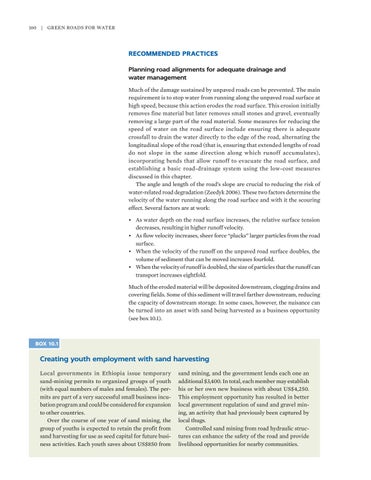160 | Green Roads for Water
RECOMMENDED PRACTICES Planning road alignments for adequate drainage and water management Much of the damage sustained by unpaved roads can be prevented. The main requirement is to stop water from running along the unpaved road surface at high speed, because this action erodes the road surface. This erosion initially removes fine material but later removes small stones and gravel, eventually removing a large part of the road material. Some measures for reducing the speed of water on the road surface include ensuring there is adequate crossfall to drain the water directly to the edge of the road, alternating the longitudinal slope of the road (that is, ensuring that extended lengths of road do not slope in the same direction along which runoff accumulates), incorporating bends that allow runoff to evacuate the road surface, and establishing a basic road-drainage system using the low-cost measures discussed in this chapter. The angle and length of the road’s slope are crucial to reducing the risk of water-related road degradation (Zeedyk 2006). These two factors determine the velocity of the water running along the road surface and with it the scouring effect. Several factors are at work: • As water depth on the road surface increases, the relative surface tension decreases, resulting in higher runoff velocity. • As flow velocity increases, sheer force “plucks” larger particles from the road surface. • When the velocity of the runoff on the unpaved road surface doubles, the volume of sediment that can be moved increases fourfold. • When the velocity of runoff is doubled, the size of particles that the runoff can transport increases eightfold. Much of the eroded material will be deposited downstream, clogging drains and covering fields. Some of this sediment will travel farther downstream, reducing the capacity of downstream storage. In some cases, however, the nuisance can be turned into an asset with sand being harvested as a business opportunity (see box 10.1).
BOX 10.1
Creating youth employment with sand harvesting Local governments in Ethiopia issue temporary sand-mining permits to organized groups of youth (with equal numbers of males and females). The permits are part of a very successful small business incubation program and could be considered for expansion to other countries. Over the course of one year of sand mining, the group of youths is expected to retain the profit from sand harvesting for use as seed capital for future business activities. Each youth saves about US$850 from
sand mining, and the government lends each one an additional $3,400. In total, each member may establish his or her own new business with about US$4,250. This employment opportunity has resulted in better local government regulation of sand and gravel mining, an activity that had previously been captured by local thugs. Controlled sand mining from road hydraulic structures can enhance the safety of the road and provide livelihood opportunities for nearby communities.







































